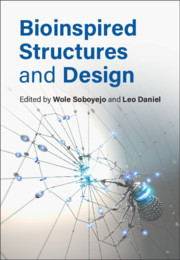Refine search
Actions for selected content:
2076 results in Aerospace engineering
13 - Biomimetic and Soft Robotics
- from Part III - Natural Phenomena
-
-
- Book:
- Bioinspired Structures and Design
- Published online:
- 28 August 2020
- Print publication:
- 17 September 2020, pp 320-342
-
- Chapter
- Export citation
5 - Bioinspired Underwater Propulsors
- from Part II - Structures
-
-
- Book:
- Bioinspired Structures and Design
- Published online:
- 28 August 2020
- Print publication:
- 17 September 2020, pp 113-139
-
- Chapter
- Export citation
4 - Bamboo-Inspired Materials and Structures
- from Part I - Materials
-
-
- Book:
- Bioinspired Structures and Design
- Published online:
- 28 August 2020
- Print publication:
- 17 September 2020, pp 89-110
-
- Chapter
- Export citation
Contents
-
- Book:
- Bioinspired Structures and Design
- Published online:
- 28 August 2020
- Print publication:
- 17 September 2020, pp v-vi
-
- Chapter
- Export citation
12 - Designing Nature-Inspired Liquid-Repellent Surfaces
- from Part III - Natural Phenomena
-
-
- Book:
- Bioinspired Structures and Design
- Published online:
- 28 August 2020
- Print publication:
- 17 September 2020, pp 300-319
-
- Chapter
- Export citation
10 - Aquatic Animals Operating at High Reynolds Numbers
- from Part III - Natural Phenomena
-
-
- Book:
- Bioinspired Structures and Design
- Published online:
- 28 August 2020
- Print publication:
- 17 September 2020, pp 235-270
-
- Chapter
- Export citation
Contributors
-
- Book:
- Bioinspired Structures and Design
- Published online:
- 28 August 2020
- Print publication:
- 17 September 2020, pp vii-x
-
- Chapter
- Export citation
2 - Human Cortical Bone as a Structural Material
- from Part I - Materials
-
-
- Book:
- Bioinspired Structures and Design
- Published online:
- 28 August 2020
- Print publication:
- 17 September 2020, pp 20-44
-
- Chapter
- Export citation
Part III - Natural Phenomena
-
- Book:
- Bioinspired Structures and Design
- Published online:
- 28 August 2020
- Print publication:
- 17 September 2020, pp 233-354
-
- Chapter
- Export citation
7 - Bionic Organs
- from Part II - Structures
-
-
- Book:
- Bioinspired Structures and Design
- Published online:
- 28 August 2020
- Print publication:
- 17 September 2020, pp 167-192
-
- Chapter
- Export citation
14 - Bioinspired Building Envelopes
- from Part III - Natural Phenomena
-
-
- Book:
- Bioinspired Structures and Design
- Published online:
- 28 August 2020
- Print publication:
- 17 September 2020, pp 343-354
-
- Chapter
- Export citation
11 - Flying of Insects
- from Part III - Natural Phenomena
-
-
- Book:
- Bioinspired Structures and Design
- Published online:
- 28 August 2020
- Print publication:
- 17 September 2020, pp 271-299
-
- Chapter
- Export citation
Part II - Structures
-
- Book:
- Bioinspired Structures and Design
- Published online:
- 28 August 2020
- Print publication:
- 17 September 2020, pp 111-232
-
- Chapter
- Export citation
Index
-
- Book:
- Bioinspired Structures and Design
- Published online:
- 28 August 2020
- Print publication:
- 17 September 2020, pp 355-360
-
- Chapter
- Export citation
Part I - Materials
-
- Book:
- Bioinspired Structures and Design
- Published online:
- 28 August 2020
- Print publication:
- 17 September 2020, pp 1-110
-
- Chapter
- Export citation

Bioinspired Structures and Design
-
- Published online:
- 28 August 2020
- Print publication:
- 17 September 2020
Index
-
- Book:
- Introduction to Spacecraft Thermal Design
- Published online:
- 19 June 2020
- Print publication:
- 09 July 2020, pp 355-360
-
- Chapter
- Export citation
Nomenclature
-
- Book:
- Introduction to Spacecraft Thermal Design
- Published online:
- 19 June 2020
- Print publication:
- 09 July 2020, pp xxi-xxv
-
- Chapter
- Export citation
Appendices
-
- Book:
- Introduction to Spacecraft Thermal Design
- Published online:
- 19 June 2020
- Print publication:
- 09 July 2020, pp 341-354
-
- Chapter
- Export citation
Dedication
-
- Book:
- Introduction to Spacecraft Thermal Design
- Published online:
- 19 June 2020
- Print publication:
- 09 July 2020, pp vii-viii
-
- Chapter
- Export citation
